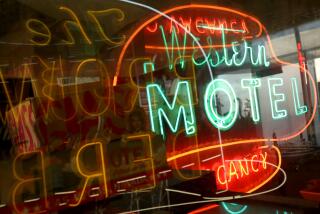Some Rare Bucks Worth Big Bucks : Goldome Money Collection at Anaheim Museum traces ups, downs and beauty of the almighty dollar
- Share via
Call it bread or bucks, cabbage or cash, the Anaheim Museum has a lobby full of it just waiting to be ogled.
It’s the Goldome Money Collection, an exhibit of more than 70 pieces of historic American currency on display through Friday. The touring collection is making its only Southern California stop this year in Anaheim and with it on display is a rare gathering of presidential autographs, including the “John Hancocks” of George Washington, Thomas Jefferson and Millard Fillmore, who once served on the board of the 150-year-old Goldome Bank, the Buffalo, N.Y.-based financial-services company that is sponsoring the exhibit.
The currency exhibit, curated by former antique-money broker Thomas Ruffino, examines the checkered past of the almighty dollar.
It seems that in 1861, after various false starts that left the nation’s banking system in a shambles, Congress adopted a plan by Secretary of the Treasury Salmon P. Chase that marked the beginning of a centralized paper currency system. According to Ruffino, the idea was less than a smash hit.
“Before the government became involved in issuing currency, banks in individual states could print their own money,” Ruffino explained during a recent interview. “The currency was backed only by their assets, so if there was a run on the bank, well, you’d just be out of luck.
“Plenty of banks went under and people lost everything they had, so when the government started producing paper currency--even though it was backed by gold or silver--people were not real excited about the idea.”
An anecdote in Gene Hessler’s “Comprehensive Catalog of U.S. Paper Money” illustrates just how bad things got.
“The bank of Battle Creek, Mich., (1838-1840) used the ruse of having its cashier . . . run out the back door whenever a note holder came in the front,” Hessler wrote. “The ‘pigeon’ found the bank deserted except for a singing janitor, who eventually drove the note holder away by singing out of tune and answering all questions with gibberish.”
Even after Congress authorized a national paper currency, there were still plenty of changes ahead for the greenback.
“You saw a lot of experiments taking place,” Ruffino said. “There were treasury notes, national bank notes, gold and silver certificates. Basically, it was a series of making mistakes and learning from mistakes.”
The small-size bills we use today were introduced in 1929, Ruffino said. Since that time, the appearance of our currency has been fairly constant, with, for example, occasional wording changes to reflect how the money is backed. (When the U.S. went off the gold standard in 1933 and off the silver standard in the 1960s, the words “redeemable in gold” and “redeemable in silver” no longer appeared on bills.)
The Goldome exhibit includes some of the unique faces that have adorned the dollar during its long evolution. There is an 1878 $5 silver certificate with a regal portrait of Sioux Chief OnePapa, the only U.S. note to feature an American Indian.
A $10 “buffalo bill,” circa 1905, has a devilishly handsome bison flanked by small portraits of explorers Lewis and Clark. (The buffalo, Black Diamond, is said to be the same fellow who modeled for the back of the Indian head nickel and a 1923 postage stamp.) The note is the largest-size paper currency ever issued, roughly 50% larger than our current bills.
For security reasons, Ruffino would not reveal the value of the Goldome Money Collection, but he said some rare bills, such as a “Technicolor” $20 gold certificate issued in 1865, could bring several thousand dollars.
The museum has beefed up its usual security measures for this exhibit, museum director Herb Pruitt said. In addition, the display pieces are double sealed inside plexiglass cases.
Three bills from the Educational Series of 1896 are by far the most elaborate in the show. Instead of the usual stuffed-shirt portraits, the engravings on these notes show allegorical figures meant to capture a nation’s high-minded spirit. There is “History Instructing Youth,” a $1 bill on which a Romanesque beauty and a young boy (apparently deep into a civics lesson) gaze across the Potomac at the Capitol dome. “Science Presenting Steam & Electricity to Commerce & Manufacture,” a $2 bill, features five capable-looking women ranging in age from fresh-faced grade-schooler to sage matron.
The engraving “Electricity as the Dominant Force of the World,” shown on a $5 bill, centers on a scantily clad goddess holding a light bulb aloft. (According to Hessler’s catalogue, this bill, considered to be the most beautiful American currency ever printed, was doomed to brief circulation, thanks to one Anthony Comstock of the Watch and Ward Society. It seems the maiden’s attire was a little too electrifying for Mr. Comstock, who ultimately forced the Treasury Department to stop printing the bills and even to recall many of them. As a result, these notes in new condition are highly valuable.)
Also included in the show are samples of “fractional currency” issued during and after the Civil War. Printed in values of 3 cents to 50 cents, the tiny bills took the place of increasingly scarce coins, which quickly vanished into hoarder’s chests and melting pots. Between 1862 and 1876, more than $368 million in fractional currency was issued. Today, fractional currency in good condition can fetch several hundred dollars from collectors.
The Goldome Money Collection and the presidential signature exhibit continue through Friday at the Anaheim Museum, 241 S. Anaheim Blvd. Admission is free; donations are accepted. The museum also features a changing exhibit on the history of Anaheim, which continues through the end of the year in the North and South galleries. Museum hours are Wednesday through Friday, 10 a.m. to 4 p.m.; Saturday, noon to 4 p.m. For information, call (714) 778-3301.
More to Read
Sign up for Essential California
The most important California stories and recommendations in your inbox every morning.
You may occasionally receive promotional content from the Los Angeles Times.













